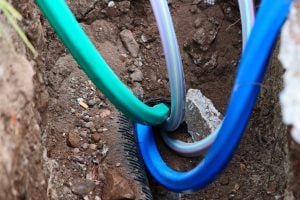South Africa’s shocking school dropout rate revealed

South Africa’s education system is in dire straits, with over 40% of South African students not making it to matric.
Although it is difficult for the department to establish the exact number of South African learners who have left the schooling system, there are two metrics that the department uses to determine the percentage of students who have dropped out per Grade.
Firstly, there is Stats SA’s General Household Survey, done annually and collects information regarding the highest level of education attained by each household member.
According to the estimates, the average dropout across each Grade comes to about 4.5%; however, most occur from Grades 9 to 11.
“Based on this methodology, data collected in a particular year is reflective of dropping out in the years preceding that year, but not necessarily of dropping out in that year,” the minister stressed.
From 2019 to 2021 – three years are combined to establish a more stable estimate – roughly 30% of leaders dropped out from grade 9 to 11.
Looking at the data, only 57.9% of South African children matriculated from 2019 to 2021.
When looking at the data more positively, there has been a steady rise in the number of students who have completed matric, with only 51.1% of South African students finishing matric from 2015-2017.
The GHS data can be found below:
| 2015-17 % in Grade | Grade Dropout | 2015-17 % in Grade | Grade Dropout | 2017-19 % in Grade | Grade Dropout | |
| Total Cohort | 100% | – | 100% | – | 100% | – |
| No schooling | – | 0.6% | – | 0.6% | – | 0.7% |
| Grade 1 | 99.4% | 0.2% | 99.4% | 0.1% | 99.3% | 0.0% |
| Grade 2 | 99.3% | 0.2% | 99.3% | 0.3% | 99.3% | 0.2% |
| Grade 3 | 99.1% | 0.5% | 99.0% | 0.2% | 99.1% | 0.2% |
| Grade 4 | 98.6% | 0.4% | 98.8% | 0.3% | 98.9% | 0.4% |
| Grade 5 | 98.2% | 0.6% | 98.5% | 0.6% | 98.4% | 0.4% |
| Grade 6 | 97.6% | 1.5% | 97.8% | 1.4% | 98.0% | 1.3% |
| Grade 7 | 96.2% | 2.9% | 96.5% | 2.7% | 96.7% | 1.9% |
| Grade 8 | 93.4% | 4.7% | 93.9% | 4.3% | 94.9% | 3.8% |
| Grade 9 | 89.0% | 9.3% | 89.9% | 8.9% | 91.3% | 6.8% |
| Grade 10 | 80.7% | 15.6% | 81.9% | 15.3% | 85.1% | 12.4% |
| Grade 11 | 68.2% | 25.0% | 69.3% | 23.7% | 74.6% | 22.4% |
| Grade 12 | 51.1% | – | 52.9% | – | 57.9% | – |
The second approach is to use Education Management Information System (EMIS) data, which looks at the departure ratios of each Grade.
The term “departing” is used as students may have left the system due to death, emigration, transfer to a college or because they finished matric – hence the significant increase in departures in the matric year.
“When analysing EMIS data, it is impossible to know the reason for the departure. These statistics also have limitations, mainly because for around 17% of learners who stay from one year to the next, national ID numbers cannot link the learners across the two years,” the minister said.
“This non-linkage problem reduces substantially to just 3% if variables other than the ID number are used, but even this presents challenges for calculating the flow statistics.
“A key question is whether apparent drop-ins from one year to the next are actually the same learners as apparent dropouts from the previous year.”
That said, the department was still able to estimate departure ratios using the EMIS data for the years ended 2018, 2019 and 2020, which can be found below:
State of education
The shocking dropout rate should, however, not be a surprise, as South Africa has one of the worst-performing education systems in the world, according to the Centre for Development and Enterprise (CDE).
Although South Africa spends roughly 13% of its revenue on basic education, which should create competitive learning levels and a large, trainable workforce, CDE’s Executive Director Ann Bernstein said there is little to show for it.
Several international benchmarks have also highlighted the dire state of South Africa’s education system over the last two decades, with some notable results including:
- After a year of school, more than 50% of Grade 1 learners don’t know all the letters in the alphabet.
- 78% of Grade 4 learners could not read for meaning in any language.
- Out of 39 participating countries, South Africa’s Grade 9 learners – on a test designed for Grade 8s – placed 38th (second last) in mathematics proficiency and last place (39th) in science proficiency.
- Covid 19 lockdowns devastated learning in South Africa (as elsewhere). Experts believe the average 10-year-old knows less than the average 9-year-old before the pandemic.
Concerningly, countries far poorer than South Africa, including Morocco, Egypt, Georgia, Kosovo and Albania, outperform these international benchmarks.
The situation is worsened by the absence of quality teachers in South Africa, with only 41% of South African teachers having adequate proficiency levels, far lower than Kenya (95%) and Zimbabwe (87%).
Large-scale absenteeism – the worst in SADC – and widespread corruption in hiring teachers have also impacted the nation’s education landscape.
However, the CDE did have five recommendations that could help South Africa’s ailing basic education:
- Tackle corruption and state capture in education by prohibiting cadre deployment and introducing measures that remove SADTU’s stranglehold on education departments.
- Raise accountability levels by bringing back the Annual National Assessment (ANA) tests for Grades 1 to 9, reinvigorating an independent National Education Evaluation and Development Unit (NEEDU), and giving principals more power over the appointment and management of teachers in their schools.
- Improve teacher performance by introducing higher teacher training standards, more effective support for existing teachers and the urgent recruitment of skilled foreign teachers in areas of shortage (maths and science).
- Install fresh leadership in public education. South Africa needs a new Minister of Basic Education, DG and the top team at national and provincial levels to achieve systemwide reform. The President’s full support for tough political decisions is essential.
- Set realistic national and provincial performance goals. Stretch targets are required to move off the bottom of international tests. Ensuring all 10-year-olds can read for meaning by 2030 is another worthy goal, but a plan, a budget and regular reporting on progress must accompany this presidential aspiration dating back to 2019.



















